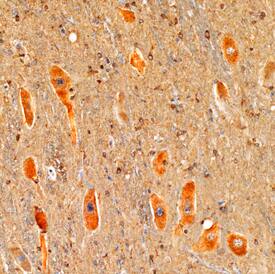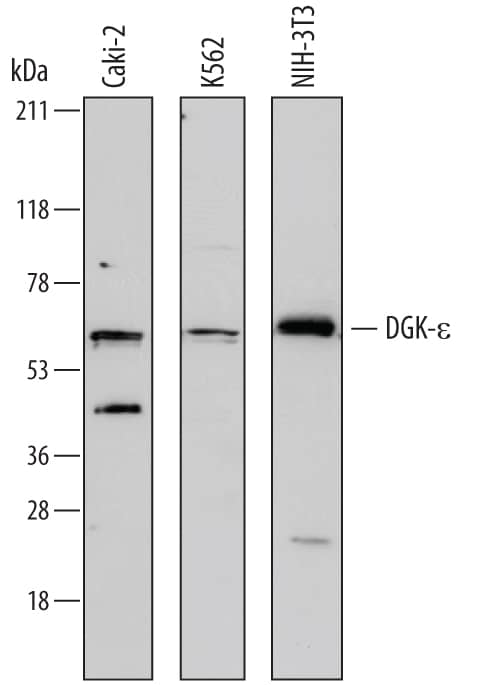Human/Mouse DGK-epsilon Antibody
R&D Systems, part of Bio-Techne | Catalog # AF7069

Key Product Details
Species Reactivity
Applications
Label
Antibody Source
Product Specifications
Immunogen
Asn314-Arg435
Accession # P52429
Specificity
Clonality
Host
Isotype
Scientific Data Images for Human/Mouse DGK-epsilon Antibody
Detection of Human and Mouse DGK‑ epsilon by Western Blot.
Western blot shows lysates of Caki-2 human clear cell carcinoma epithelial cell line, K562 human chronic myelogenous leukemia cell line, and NIH-3T3 mouse embryonic fibroblast cell line. PVDF membrane was probed with 1 µg/mL of Sheep Anti-Human DGK-e Antigen Affinity-purified Polyclonal Antibody (Catalog # AF7069) followed by HRP-conjugated Anti-Sheep IgG Secondary Antibody (Catalog # HAF016). A specific band was detected for DGK-e at approximately 65 kDa (as indicated). This experiment was conducted under reducing conditions and using Immunoblot Buffer Group 1.DGK‑ epsilon in Human Brainstem.
DGK-e was detected in immersion fixed paraffin-embedded sections of human brainstem using Sheep Anti-Human DGK-e Antigen Affinity-purified Polyclonal Antibody (Catalog # AF7069) at 10 µg/mL overnight at 4 °C. Tissue was stained using the Anti-Sheep HRP-DAB Cell & Tissue Staining Kit (brown; Catalog # CTS019) and counterstained with hematoxylin (blue). Specific staining was localized to neuronal cell bodies and processes. View our protocol for Chromogenic IHC Staining of Paraffin-embedded Tissue Sections.Applications for Human/Mouse DGK-epsilon Antibody
Immunohistochemistry
Sample: Immersion fixed paraffin-embedded sections of human brainstem
Western Blot
Sample: Caki‑2 human clear cell carcinoma epithelial cell line, K562 human chronic myelogenous leukemia cell line, and NIH‑3T3 mouse embryonic fibroblast cell line
Formulation, Preparation, and Storage
Purification
Reconstitution
Formulation
Shipping
Stability & Storage
- 12 months from date of receipt, -20 to -70 °C as supplied.
- 1 month, 2 to 8 °C under sterile conditions after reconstitution.
- 6 months, -20 to -70 °C under sterile conditions after reconstitution.
Background: DGK-epsilon
DGK-epsilon (Diacylglycerol kinase epsilon) is a 65 kDa member of the eukaryocytic diacylglycerol kinase family of enzymes. It is a type III DGK that possesses only a C1/Cys-rich domain and a catalytic region, and is found in neurons and testis. DGK-epsilon specifically phosphorylates arachidonate-containing DAG, and may downregulate DAG signaling that results from inositol cycling. Human DGK-epsilon is 567 amino acids (aa) in length. It would appear to contain one transmembrane domain (aa 22-42), two C1 DAG-binding regions (aa 59-108 and 124-177) and one catalytic domain (aa 219-350). DGK-epsilon apparently can form intramembrane oligomers. Over aa 314-435, human DGK-epsilon shows 99% aa identity to mouse DGK-epsilon.
Long Name
Alternate Names
Gene Symbol
UniProt
Additional DGK-epsilon Products
Product Documents for Human/Mouse DGK-epsilon Antibody
Product Specific Notices for Human/Mouse DGK-epsilon Antibody
For research use only

